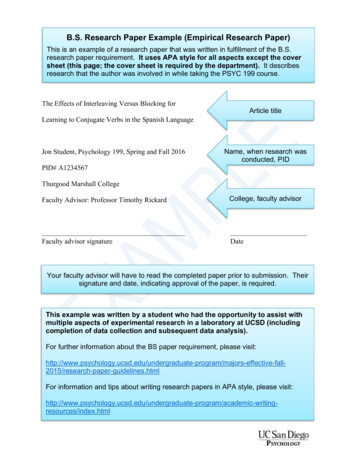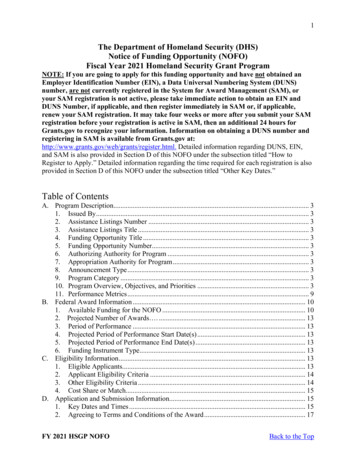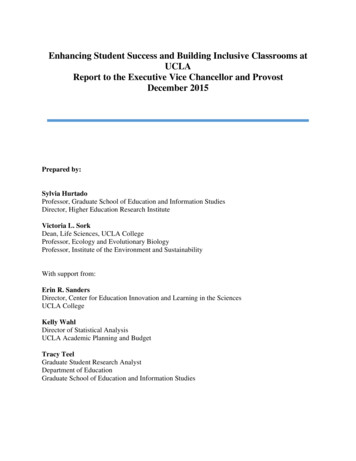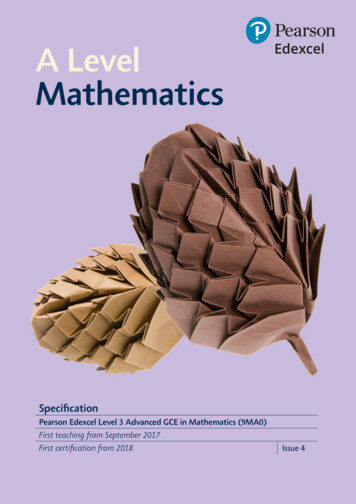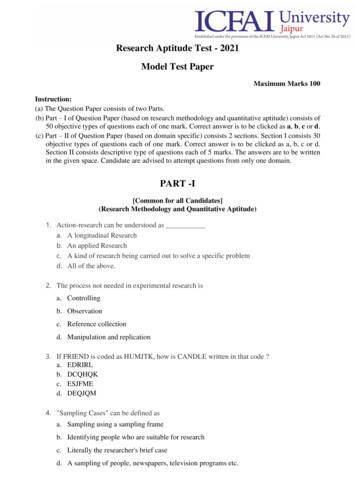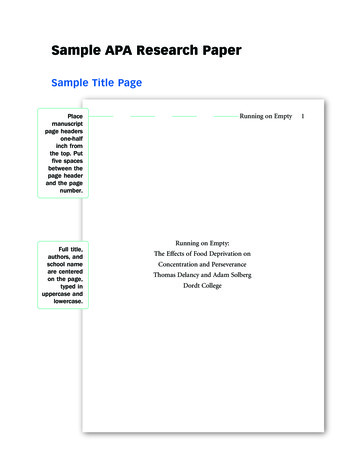
Transcription
2022 JETIR June 2022, Volume 9, Issue 6www.jetir.org (ISSN-2349-5162)Research Paper on Enhancing Information BasedLearning System Using Educational Data Mining1Mukesh Chandra, 2Priyanka Sharma1Research Scholar, 2 Asstt ProfessorComputer Science and Engineering1School of Research and Technology, People's University, Bhopal (M.P.) India1Abstract : In this data world, where druggies generate their digital footmark and induce a huge quantum of unshaped data continuously witheach exertion, data mining ways help in discovering intriguing patterns, establishing connections and unravel the problems through analysis,in different aspects of life. Educational data mining is a multidisciplinary exploration area, in which data from colorful educationalassociations, is explored and made functional, for colorful angles concerned with the scholars, like prognosticating academic performance,assay the literacy pattern, working e-learning issues, prognosticate employability, fantasize the critical courses affecting performance, probethe reasons for pupil’s failure or drop out and therefore make data- driven opinions to ameliorate the institutions norms. This paper providesa brief overview of Data Mining tools and ways, and its encroachment in the educational sphere. It also proposes a simple frame usingdifferent variables which helps in prognosticating pupil’s academic success using two different algorithms Decision Trees and BayesianNetwork. Eventually, a relative analysis of delicacy is done. The results show that Bayesian Network outperforms the Decision Tress andgives better delicacy.Educational Data Mining( EDM) is a platform for knowledge and exploring from data to get essential information and induce the uniquepattern which will help study, assay and skill pupil performance in academic. various data mining styles can be apply to sludge the data fromdata storage to apply data mining ways which helps pupil for taking opinions for better outgrowth. The model which can be use inEducational data mining must be a constructive and descriptive model applied on data storage and must gather truly accurate data forenhance the performance of study.IndexTerms — Educational Data Mining, Cluster Analysis, Classification, Regression Model, K-Means.I. INTRODUCTIONData Mining is the most prevailing fashion in currently that helps educational institutions to prognosticate their pupil’s gets, performance andat- threat scholars. This is the fashion that helps educational achievements and in assessment of scholars ‟ literacy capabilities. Usingeducational data mining huge data of institutions is booby-trapped to carry out useful information. EDM is also used to manage literacymaterial using different tools like Learning Management Systems. Over the once decade there has been a rapid-fire growth in advancededucation system. A lot of new institutions have come up both from public and private sector offering variety of courses for under graduatingand post graduating scholars.The alternate step is the conduct hunt for primary studies, and barred are the studies that aren't applicable to answer. Then the explorationquestions to drive the structure are handed. The third step is icing that the scheme takes the being studies into account and furnishing betterresults. Answering the exploration questions provides data birth and complete mapping of studies, by relating, analysing and interpreting theapplicable substantiation. The bracket scheme drives the field of interests, videotape field of interest and technology used in FuzzyClustering.Cluster of StudentsIn this case groups of scholars are created harmonious with their customized features, particular characteristics, etc. These clusters/ groups ofscholars are constantly employed by the preceptor/ innovator to produce a customized knowledge system which may promote effective groupknowledge. The DM ways employed in this task are type and clustering. Different clustering algorithms that are used to group scholars arehierarchical agglomerative clustering, K- means and model- predicated clustering. A clustering algorithm is rested on large generalizedsequences which help to seek out groups of scholars with similar knowledge characteristics like hierarchical clustering algorithm which areemployed in intelligent- literacy systems to group scholars harmonious with their individual knowledge style preferences.Registration ManagementThis term is generally employed in education to explain well- planned strategies and tactics to shape the enrollment of an establishment andmeet established pretensions. Registration operation is an organizational generality and a scientific set of exertion designed to enableeducational institutions to ply farther influence over their pupil registrations. analogous practices constantly include marketing, admissionprograms, retention programs, and aid awarding. Strategies and tactics are informed by collection, analysis, and use of knowledge to projectJETIR2206554Journal of Emerging Technologies and Innovative Research (JETIR) www.jetir.orgf428
2022 JETIR June 2022, Volume 9, Issue 6www.jetir.org (ISSN-2349-5162)successful issues. Conditioning that yield measurable advancements in yields are continued and/ or expanded, while those exertion that don'tare discontinued or restructured. Competitive sweats to retain scholars are a standard emphasis of enrolment directors.Survey and Determination of DataIt's used to illuminate useful information and support deciding. within the educational terrain, for case, it can help instructors and coursedirectors to probe the scholars course exertion and operation information to prompt a general view of a pupil’s knowledge. Statistics andvisualization information are the 2 main ways that are most generally used for this task. Statistics may be a fine wisdom concerning thegathering, analysis, interpretation or explanation, and donation of knowledge. it's fairly easy to prompt introductory descriptive statisticsfrom statistical software, like SPSS.Predicting Student PerformanceIn this case, we estimate the unknown value of a variable that describes the pupil. In education, the values generally predicted are pupil’sperformance, their knowledge, score, or marks. This value can be numerical/ continuous (regression task) or categorical/ separate ( typetask). Retrogression analysis is used to find relation between a dependent variable and one or further independent variables. type is used togroup individual particulars predicated upon quantitative characteristics essential in the particulars or on training set of previously labelledparticulars. Vaccination of a pupil’s performance is the most popular operations of DM in education. Different ways and models are appliedlike neural networks, Bayesian networks, rule predicated systems, regression, and correlation analysis to anatomize educational data. Thisanalysis helps us to predict pupil’s performance i.e. to predict about his success in a course and to predict about his final grade predicated onfeatures pulled from logged data.BACKGROUND AND RELATED WORKIn this section we plant that numerous authors have tried to find out the fashion by which the educational data can take filtration at optimumposition. Colorful clusters can be created by the experimenters so that the educational data must be simplifies in proper manner. They alsoused colorful algorithms to prognosticate the accurate data. It helps to identify the scholars’ performance range like average, below average,and good performance. As there are several approaches that area unit used for knowledge bracket. This study can grease the scholars and thespeakers to boost the scholars of all order to perform well.J K Jothi and K Venkatalakshmi conducted the students’ performance analysis on the graduate students’ data collected from theVillupuram college of Engineering and Technology. The data included five year period and applied clustering methods on the data toovercome the problem of low score of graduate students, and to raise students academic performance.[1]Sheik and Gadage have done the analysis related to the student learning behavior by using different data mining models, namelyclassification, clustering, decision tree, sequential pattern mining and text mining. They used open source tools such as KNIME (KonstanzInformation Miner), RAPIDMINER, WEKA, CARROT, ORANGE, RProgramming, and iDA. These tools have different compatibilities andit provided an insight into the prediction and evaluvation.[2]Mythili M S and Shanavas A R applied classification algorithms to analyze and evaluate school students’ performance using weka. Theycame with various classification algorithms, namely J48, Random Forest,Multilayer perception, IBI and decision table with the data collected from the student management system [3].Dinesh A and Radhika V targeted on the techniques and strategies of instructional data processing for data discovery from the informationcollected from various universities. This paper stated that relationship mining was leading between 1995 and 2005 and in 2008 to 2009 itslipped to 5th place. During the period 2008 to 2015 45% papers are moving to prediction. The prediction model acts like a warning systemto improve their performance [4].Osmanbegovic and Suljic conducted a study for investigating students’ future performance in the end semester results at the University ofTuzla. They considered 11 factors and used classification model with highest accuracy for naive Bayes [5].Suyal and Mohod applied the association and classification rule to identify the students’ performance. They mainly focused to find thestudents who need special attention to reduce failure rate [6].Noah, Barida and Egerton conducted a study to evaluate students’ performance by grouping the grading into various classes using CGPA.They used different methods like Neural network, Regression and K-means to identify the weak performers for the purpose of performanceimprovement. The prediction with high accuracy in students' performance is beneficial as it helps in identifying the students with lowacademic achievements at the early stage of acdemics. [7].Baradwaj and pal described data mining techniques that help in early identification of student dropouts and students who need specialattention. Here they used a decision tree by using information like attendance, class test, sem and assignment marks [8].Jeevalatha, Ananthi, and Saravana Kumar presented a case study on performance analysis for placement selection for undergraduatestudents. They applied decision tree algorithm by considering the factors like HSC, UG marks and communication skills [9].Backer and Yacef conducted a study for identifying the most appropriate model for EDM. They analyzed data and reached the conclusionthat most of the papers adopt prediction than relationship mining [10].ElGamal A F presented a study for predicting student performance in a programming course. Here the data is collected from the departmentof computer science from Mansoura University and applied extract rules for predicting students’ performance in programming course [11].Angeline D M conducted a study on the students’ performance by using Apriori algorithm that extracts the set of rules specific to everycategory and analyze the given knowledge to classify the scholar based on their involvement in assignment, internal assessment test, groupaction etc. It helps to identify the students’ performance range like average, below average, and good performance [12].Bhise, Thorat and Supekar presented a method using K-means clustering algorithm by describing it step by step. This paper mainlyfocused on reducing drop-out-ratio of the students and improve it by considering the valuation factors like midterm and final examassignment. They considered different clustering techniques namely hierarchical, partitions, and categorical. This study can facilitate thestudents and the lecturers to boost the students of all category to perform well. [13].Remesh, Parkavi, and Yasodha conducted a study on the placement chance prediction by investigating the different techniques such asNaive Bayes Simple, MultiLayerPerception, SMO, J48, and REPTree by its accuracy. From the result they concluded thatMultiLayerPerception technique is more suitable than other algorithms [14].Tair M M A and El-Halees presented a case study with a set of data collected from degree holders of college ‘Science and Technology,Khanyounis’, during the period of 1993 to 2007. They used two classification methodologies such as Rule Induction and Naive Bayesianclassifier to forecast the grades of the students. classification is employed in student information to predict the students' division on thepremise of previous information. [15].JETIR2206554Journal of Emerging Technologies and Innovative Research (JETIR) www.jetir.orgf429
2022 JETIR June 2022, Volume 9, Issue 6www.jetir.org (ISSN-2349-5162)II. BACKGROUND AND RELATED WORKIn this section we plant that numerous authors have tried to find out the fashion by which the educational data can take filtration at optimumposition. Colorful clusters can be created by the experimenters so that the educational data must be simplifies in proper manner. They alsoused colorful algorithms to prognosticate the accurate data. It helps to identify the scholars’ performance range like average, below average,and good performance. As there are several approaches that area unit used for knowledge bracket. This study can grease the scholars and thespeakers to boost the scholars of all order to perform well.J K Jothi and K Venkatalakshmi conducted the students’ performance analysis on the graduate students’ data collected from theVillupuram college of Engineering and Technology. The data included five year period and applied clustering methods on the data toovercome the problem of low score of graduate students, and to raise students academic performance.[1]Sheik and Gadage have done the analysis related to the student learning behavior by using different data mining models, namelyclassification, clustering, decision tree, sequential pattern mining and text mining. They used open source tools such as KNIME (KonstanzInformation Miner), RAPIDMINER, WEKA, CARROT, ORANGE, RProgramming, and iDA. These tools have different compatibilities andit provided an insight into the prediction and evaluvation.[2]Mythili M S and Shanavas A R applied classification algorithms to analyze and evaluate school students’ performance using weka. Theycame with various classification algorithms, namely J48, Random Forest,Multilayer perception, IBI and decision table with the data collected from the student management system [3].Dinesh A and Radhika V targeted on the techniques and strategies of instructional data processing for data discovery from the informationcollected from various universities. This paper stated that relationship mining was leading between 1995 and 2005 and in 2008 to 2009 itslipped to 5th place. During the period 2008 to 2015 45% papers are moving to prediction. The prediction model acts like a warning systemto improve their performance [4].Osmanbegovic and Suljic conducted a study for investigating students’ future performance in the end semester results at the University ofTuzla. They considered 11 factors and used classification model with highest accuracy for naive Bayes [5].Suyal and Mohod applied the association and classification rule to identify the students’ performance. They mainly focused to find thestudents who need special attention to reduce failure rate [6].Noah, Barida and Egerton conducted a study to evaluate students’ performance by grouping the grading into various classes using CGPA.They used different methods like Neural network, Regression and K-means to identify the weak performers for the purpose of performanceimprovement. The prediction with high accuracy in students' performance is beneficial as it helps in identifying the students with lowacademic achievements at the early stage of acdemics. [7].Baradwaj and pal described data mining techniques that help in early identification of student dropouts and students who need specialattention. Here they used a decision tree by using information like attendance, class test, sem and assignment marks [8].Jeevalatha, Ananthi, and Saravana Kumar presented a case study on performance analysis for placement selection for undergraduatestudents. They applied decision tree algorithm by considering the factors like HSC, UG marks and communication skills [9].Backer and Yacef conducted a study for identifying the most appropriate model for EDM. They analyzed data and reached the conclusionthat most of the papers adopt prediction than relationship mining [10].ElGamal A F presented a study for predicting student performance in a programming course. Here the data is collected from the departmentof computer science from Mansoura University and applied extract rules for predicting students’ performance in programming course [11].Angeline D M conducted a study on the students’ performance by using Apriori algorithm that extracts the set of rules specific to everycategory and analyze the given knowledge to classify the scholar based on their involvement in assignment, internal assessment test, groupaction etc. It helps to identify the students’ performance range like average, below average, and good performance [12].Bhise, Thorat and Supekar presented a method using K-means clustering algorithm by describing it step by step. This paper mainlyfocused on reducing drop-out-ratio of the students and improve it by considering the valuation factors like midterm and final examassignment. They considered different clustering techniques namely hierarchical, partitions, and categorical. This study can facilitate thestudents and the lecturers to boost the students of all category to perform well. [13].Remesh, Parkavi, and Yasodha conducted a study on the placement chance prediction by investigating the different techniques such asNaive Bayes Simple, MultiLayerPerception, SMO, J48, and REPTree by its accuracy. From the result they concluded thatMultiLayerPerception technique is more suitable than other algorithms [14].Tair M M A and El-Halees presented a case study with a set of data collected from degree holders of college ‘Science and Technology,Khanyounis’, during the period of 1993 to 2007. They used two classification methodologies such as Rule Induction and Naive Bayesianclassifier to forecast the grades of the students. classification is employed in student information to predict the students' division on thepremise of previous information. [15].III. SURVEY METHODOLOGYIn our methodology we will use algorithm to search the prophetic data. This algorithm will help us to find the desire data in accurate manner.Decision tree algorithm under Bracket fashion can be used to find the result. It predicts the searching data for educational data mining. Thealgorithm will as follows:Algorithm Prototype:The proposed algorithm will complete in following process:1.Simulate the raw data for analysis from data warehouseIn first step data collection will be done for further process. The data will co relates various homogeneous data with large amount ofdata.2.Implementation of the classification scheme (Cleaning)Classification scheme can be implemented to divide the data in various data clusters.3.Feature Selection to reduce data complexityFeature will be formed in the mode of standardisation. Which comes to the fire in the physical data barriers with lots of features?JETIR2206554Journal of Emerging Technologies and Innovative Research (JETIR) www.jetir.orgf430
2022 JETIR June 2022, Volume 9, Issue 64.www.jetir.org (ISSN-2349-5162)Get the Classification method (K-mean) for comparative analysisThe k-mean classification method will create data clusters and compare the actual data with predictive analytical data for selectingaccurate data.5.Interpret the resultant dataResultant data can be found using comparative method with most efficient cluster and less time counter.Data ClusterData FragmentationData Filtering
classification, clustering, decision tree, sequential pattern mining and text mining. They used open source tools such as KNIME (Konstanz Information Miner), RAPIDMINER, WEKA, CARROT, ORANGE, RProgramming, and iDA. These tools have different compatibilities and it provided an insight into the prediction and evaluvation.[2]
